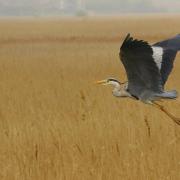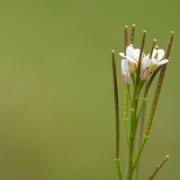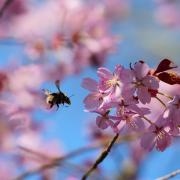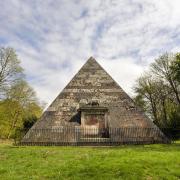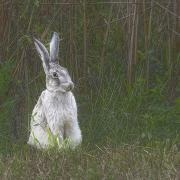When Nial Adam’s father died, he found himself obsessively painting again for the first time in years as he struggled with his bereavement

Apocalyptic brooding skies, the drama of wild frothing waves, still horizons dense with trees framed by a blood orange sun – Nial Adams paintings are things of great drama, alive with the wild majesty of the natural world.
From his studio in a centuries old barn in Hevingham, he meticulously adds layer upon layer of oils, tiny strokes of detail, creating a magical depth and atmosphere to every painting.
Nial started painting as a boy – but it was the devastating impact of bereavement which finally led him back to an easel after many decades away.

“My father Fred was an extremely accomplished and knowledgeable self-taught artist. I started painting when I was about 10 and it was something we did together. But after A-Level, I had no thoughts or plans to do anything in that field,” he says.
“Then in 2013, my father passed away and it really was a catalyst for me to change my life. Nothing prepares you for losing a parent.”
So Nial picked up a brush and began to paint.

“Manically,” he says. “I just started painting and painting. I inherited all his old materials, his brushes and his old French easel and it felt like the most obvious thing in the world. I guess there were elements of guilt at not painting alongside him more, I felt an idiot for not finding the time. There were also those feelings of regret and loss.”
His career now is a far cry from his previous professional life, a path which had led him from high risk security work in Russia and the Ukraine, via the financial services industry and then marketing.
“The security work was well paid but dangerous – it was a great life, incredibly thrilling, but gallivanting around playing James Bond wasn’t a good way to live when I had a wife at home.”

He returned to Norfolk and began working at Virgin before eventually setting up his own marketing company, working with global brands as well as closer to home with small businesses.
“Working with those small start ups was incredible satisfying, helping them go from zero to hero. But one day I was tapping away on my keyboard and although I enjoyed it, I found myself looking out of the window thinking that being a professional artist would be a pretty perfect thing to do every day.”
Initially, Nial worked at home in his conservatory, but a nearby farmer had a barn to rent – and after a little bit of renovation, it became Nial’s studio and haven.
“Although I hadn’t practiced my art for a number of years, some of that knowledge was still there. My dad’s understanding of art history was amazing; he could talk on any artist and from any period. It was a huge repository of knowledge built over a long time,” he says.
“The funny thing is, when I was young I would paint something and then ask him for advice. Suddenly he wasn’t there to ask and I found that incredibly tough. I would step back from a painting and would find myself saying ‘right, what would my dad say if he was here, is it too dark, too light?’ The strange thing is the answer would always pop into my head, like he was still there telling me.”
Like his father, Nial works in oils, painstakingly building up layers of paint to create depth and drama. His techniques are well honed, inspired by the masters he adores – in particular his favourite, Turner.
“I love working in oil because there are things you can do which you can’t do in any other medium. I am not snobbish about art, but I love the pureness and tradition of it, there is a mystical kind of alchemy in how you use oils, the complex techniques and the layers and layers which make up the painting. Sometimes it can take a week to enable a layer to dry before I can begin working on it again. Some of my paintings take months to complete.”
The Norfolk landscape is undoubtedly his inspiration and he spends time at the coast, taking photographs and sketching, pulling over excitedly to snap a certain sunset or cloud formation as he drives home.
“My kids used to moan that we would never get anywhere, but now my eldest daughter Victoria takes photographs of skies and sends them to me for inspiration. I take all these things back to the studio and begin working on ideas rather than copying exact scenes. I prefer to free paint, to create something without a preconceived plan, I think from a creative point of view that’s the most interesting way of painting.
“Friends often tell me my work is incredibly dark but to me, they are just reflecting the drama and wonder of the natural world and our landscape. Some people find a walk on the beach on a stormy, dark winter’s day, as uplifting and beautiful as on a summer’s day when the sun is shining and the sky is blue. It is about perception.”
Nial grew up in Norfolk and went to the City of Norwich School, his parents having moved to the county from London before he was born.
“They met at an art class in London, my dad was the teacher and my mum went along just to keep her friend company. They came to Norfolk on honeymoon and fell in love with it. When they moved here he opened a small shop as a framer and restorer in Elm Hill, but sadly, during the 1970s it didn’t survive. He ended up doing a number of normal jobs but he always carried on painting.”
Nial’s work already has a strong following and demand for his work is growing. Last he was a runner up in the EDP Norfolk Landscape Painter of the Year competition.
Below his studio, he now has a gallery which he opens one day a month. The ancient crumbling bricks and the old iron work sticking out from the walls remain unchanged, his work taking centre stage.
“It is a real thrill, and deeply humbling, people wanting to see and buy my work. It isn’t something utilitarian, like a car or a washing machine, they don’t need it, they want it, and for me that is a real privilege,” he says.
“My only sadness it that I stand here and look at these pieces and I want to say ‘Dad, what do you think?’ But conversely, I would never have painted them if he hadn’t died. That was the catalyst for all of this.”




